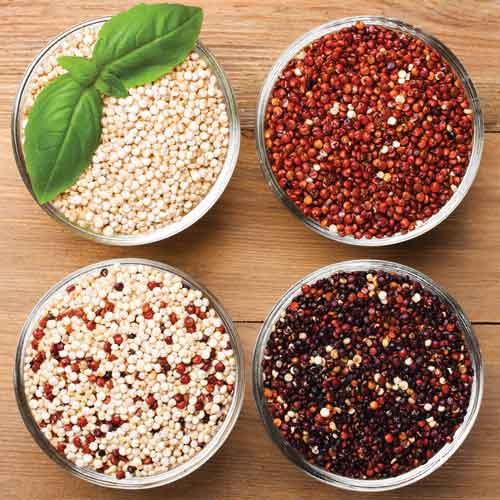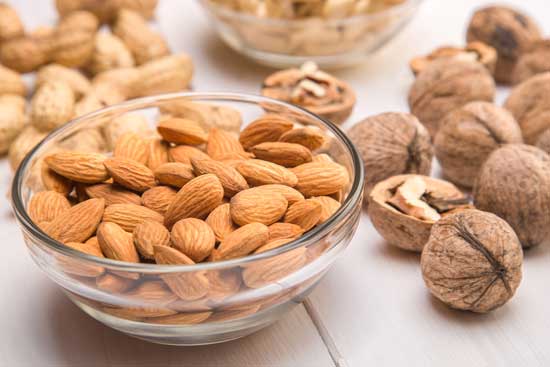Identifying antioxidants in chocolate; Gauging GMO acceptance
NEWS
Choosing quinoa for extrusion
An ancient grain native to Andean regions of South America, quinoa has grown in popularity in recent years thanks to its protein and fiber content and is now used in a wide range of products, including extruded ones. Certain varieties of the seed were found to perform better in the extrusion process, according to a recent study in the Journal of Food Science.
 Two quinoa varieties—Cherry Vanilla and Black (scarified (physically abrading seeds to remove bitter saponins) and unscarified) and one mixed variety (Bolivian Royal; scarified and degermed) were studied for their extrusion characteristics. The researchers found that degermed Bolivian Royal showed the highest expansion in comparison to all other varieties, which was attributed to its high starch content. “Because Bolivian Royal was largely starch, the other components, such as fat, fiber, or protein, were not competing for the absorption of water or hindering the absorption of water by the starch,” the researchers write.
Two quinoa varieties—Cherry Vanilla and Black (scarified (physically abrading seeds to remove bitter saponins) and unscarified) and one mixed variety (Bolivian Royal; scarified and degermed) were studied for their extrusion characteristics. The researchers found that degermed Bolivian Royal showed the highest expansion in comparison to all other varieties, which was attributed to its high starch content. “Because Bolivian Royal was largely starch, the other components, such as fat, fiber, or protein, were not competing for the absorption of water or hindering the absorption of water by the starch,” the researchers write.
The researchers also note that scarification and degerming affect the extrudate quality as they remove fat, fiber, and protein, which can limit the amount of crispiness and puffiness in the product. Scarification typically does not affect the outer layer of the seed, leaving the majority of the proteins and fibers and other nutrients intact, says researcher Girish Ganjyal; degerming removes a significant amount of the outer seed layer, and the degerming process chosen will determine what levels of nutrients remain. Since many consumers may be turning to quinoa-based products because of their association with health and wellness, Ganjyal recommends that “users of the quinoa flours talk to the ingredient vendors to get accurate information about the nutrients retained in the flours they are buying.”
Identifying antioxidants in chocolate
Researchers at the University of British Columbia developed a new method for quantifying antioxidant levels in chocolate and when they rise and fall from bean to bar during the manufacturing process.
Drawing on infrared spectroscopy, the minutes-long method illuminates chocolate samples with infrared light to record the chemical composition, including the amount of polyphenols—micronutrients with high antioxidant properties. The traditional method, which uses biochemical tests, can take hours or even days to complete.
Chocolate is processed in several stages during manufacturing, and the scientists are using this new method to determine at what points antioxidant levels are highest.
“If we identify drying as the step that significantly lowers the bean’s antioxidant properties, for example, we will want to develop a strategy to reduce the drying time, or drying temperature,” says Xiaonan Lu, an IFT professional member and assistant professor in the faculty of land and food systems, who codeveloped the method.
The method might also help manufacturers select beans with the greatest levels of antioxidants to help them produce chocolate products to appeal to health-conscious consumers.
Gauging acceptance of GMOs
Nearly half of Americans—48%—believe that foods containing genetically modified (GM) ingredients are no different than other foods, according to a survey of 1,480 U.S. adults conducted by the Pew Research Center. Thirty-nine percent of respondents, though, believe that GM foods are worse for their health than traditional foods, and 10% believe they are better. Respondents feel positive about organics, with 55% of respondents saying that organically grown produce is more healthy than conventionally grown.
While only a small percentage of Americans (16%) say they care a great deal about GMOs, three in 10 say information presented about GMOs is based on the best available evidence, with respondents also saying they trust information offered by scientists on the subject over that provided by the food industry, the media, and the government.
 Nuts may boost health
Nuts may boost health
Consuming just 20 grams of nuts per day may reduce the risk of death and chronic disease, according to research by the Imperial College London School of Public Health published in the journal BMC Medicine.
Researchers analyzed 20 population studies representing more than 820,000 participants and found that coronary heart disease, cardiovascular disease, and total cancers were reduced with high nut consumption. In addition, nuts were linked with a 24% decrease in respiratory mortality and a 32% decrease in diabetes mortality. Peanut consumption, including peanut butter, was also related to reductions in the risk of stroke and kidney disease.
“In 2013, an estimated 4.4 million deaths may be attributable to a nut intake below 20 grams per day in North and South America, Europe, Southeast Asia, and the Western Pacific,” wrote the authors. “These findings support dietary recommendations to increase nut consumption to reduce chronic disease risk and mortality.”
--- PAGE BREAK ---
Potential benefits of A2 milk
Milk containing only the A2 form of a beta-casein protein may double the concentration of glutathione (GSH), an antioxidant that has been linked to aiding the body in warding off neurodegenerative diseases and health conditions, according to a study published in the Nutrition Journal.
Milk contains whey proteins and many types of casein proteins, including A1 and A2, according to Richard Deth, lead researcher of the study. Whey proteins are rich in the amino acid named cysteine, which is needed for synthesis of GSH, and digesting A1 beta-caseins can interfere with activity of the cysteine transporter, thereby restricting cysteine availability for GSH synthesis. A2 caseins, on the other hand, block the release of the peptide responsible for blocking this transporter, making more GSH available. Deth adds that low levels of GSH have been found in cases of autism, and he says that A2 milk may help support antioxidant capacity during early childhood development. Such milk is available from companies including Ohio-based Snowville Creamery and Australia’s a2 Milk, a company that identifies cows within existing dairy herds that produce solely A2 milk, according to Bonnie Johnson, vice-president of scientific affairs.
News Bites
• AAK will hold a grand opening for its new state-of-the-art bakery and confectionery application lab.
• AB Mauri will acquire the business and assets of Specialty Blending Co., a bread and sweet goods mix manufacturer located in Cedar Rapids, Iowa. It will also endow two new college scholarships for Kansas State University’s Bakery Science and Management program. The company has committed $50,000 to fund the scholarships over the next five years.
• Bala Balasubramaniam was awarded the 2016 Asian Institute of Technology Alumni Assoc.’s Distinguished Alumni award in the category of Academic and Research Excellence.
• Sheryl Barringer and Dan Barringer recently established the Barringer Food Science & Technology Study Abroad Scholarship Fund, an unrestricted endowment that will be used to provide study abroad scholarship support to Dept. of Food Science & Technology students at The Ohio State University.
• Blueberry, a full-service marketing and sensory research agency specializing in the innovation pipeline, launched PinPoint, its unique concept and product testing methodology.
• Cargill opened two major R&D facilities in November and December 2016, one in North America and one in China.
• CHS opened a new Fargo, N.D., facility with state-of-the-art Log5 pasteurization capabilities for its nonroasted sunflower products.
• Coca-Cola will buy out Anheuser-Busch’s 54.5% stake in Coca-Cola Beverages Africa for $3.15 billion.
• Community Coffee Co. supported the opening of two schools in Chiapas, Mexico, funded in partnership with Southwest Airlines Co. and the ECOM Foundation.
• Corbion will sell its Breddo-Likwifier division to Ensight Solutions.
• DuPont Industrial Biosciences and Archer Daniels Midland Co. received the Breakthrough Solution of the Year Award from Platts Global Energy.
• Eurofins became the first independent contract laboratory in the United States to earn accreditation from the International Olive Council.
• Fruitworx, the real fruit pieces supplied by Welch’s Global Ingredients Group, were featured last month in a segment during the educational TV show Innovations with Ed Begley, Jr. that airs on the Discovery Channel.
• Brynwood Partners VII announced that its majority-owned portfolio company, Harvest Hill Beverage Co., will acquire Nestlé HealthCare Nutrition’s NUTRAMENT business.
• Healthy Food Ingredients unveiled a new brand identity, including a new logo, website, advertisements, trade show presence, and tagline, “Cultivating goodness.” It also acquired Heartland Flax.
• Highlander Partners acquired Hillside Candy.
• Ingredion entered into a stock purchase agreement to acquire all of the outstanding shares of TIC Gums.
• Invisible Sentinel’s Veriflow technology platform for the detection of STEC organisms received certification from the Assoc. of Analytical Communities.
• Kalsec received an “Excellent” rating during the recent annual Safe Quality Food Level 2 recertification, the highest rating possible.
• Laboratory Corp. of America Holdings will acquire Food Perspectives (FPI), a leader in consumer research and testing. FPI will become part of Covance’s food solutions business.
• Lloyd’s Register, the global engineering, technical, and business services organization, acquired Acoura, one of the United Kingdom’s leading providers of risk and compliance.
• McCain Foods plans to expand its production capacity for frozen french fries in North America.
• The National Assoc. for Business Resources named several food companies to its 2016 Best and Brightest Companies to Work For list, including FONA International, Bell Flavors & Fragrances, Butterball Farms, and Edlong Dairy Technologies.
• Irish exporter Ornua acquired the CoreFX Ingredients division of MCT Dairies.
• Palsgaard acquired the majority of the shares of Brazilian food ingredients company Candon Aditivos para Alimentos.
• Parker Products broke ground on a new 90,000-square-foot facility in Fort Worth, Texas.
• Sanderson Farms’ Kinston, N.C., facility was awarded the 2016 Clean Water Award by the U.S. Poultry & Egg Assoc.
• Synergy Flavors funded two projects to provide better access to primary education for children living in the vanilla-growing SAVA region of Madagascar.
• Tate & Lyle celebrated the 40th anniversary of the discovery of sucralose in 1976.
• A product development team from The Ohio State University, including IFT student members Ayna Arora and Megan Whitecotton, was named a finalist in the American Society of Baking’s 2017 Product Development Competition.
• The U.S. Dept. of Agriculture’s National Institute of Food and Agriculture announced the availability of up to $3.8 million in funding to support research, education, and extension to support organic farmers and ranchers as well as those adopting organic practices for the first time.
• The U.S. Food and Drug Administration approved Del Monte Fresh Produce’s biotech pink pineapple Rose, which has lower levels of the enzymes that convert lycopene into beta-carotene and will be labeled as “extra sweet pink flesh pineapple.”
• WACKER BIOSOLUTIONS, the life sciences and biotechnology division of the WACKER Group, is acquiring a large-scale fermentation plant from Antibióticos de León in Spain.
• Welch Foods and biochemical manufacturer Blue Marble Biomaterials will collaborate to bring naturally derived biochemicals to the public.
 Melanie Zanoza Bartelme, Associate Editor
Melanie Zanoza Bartelme, Associate Editor
[email protected]
